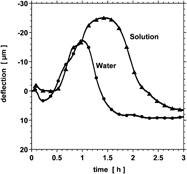Crossref Citations
This article has been cited by the following publications. This list is generated based on data provided by
Crossref.
Saidov, Tamerlan A.
Espinosa-Marzal, Rosa M.
Pel, Leo
and
Scherer, George W.
2012.
Nucleation of sodium sulfate heptahydrate on mineral substrates studied by nuclear magnetic resonance.
Journal of Crystal Growth,
Vol. 338,
Issue. 1,
p.
166.
Schiro, Mara
Ruiz-Agudo, Encarnacion
and
Rodriguez-Navarro, Carlos
2012.
Damage Mechanisms of Porous Materials due to In-Pore Salt Crystallization.
Physical Review Letters,
Vol. 109,
Issue. 26,
Scherer, George W.
2013.
Supersaturation in Porous Media.
p.
2290.
Espinosa-Marzal, Rosa M.
2013.
Confinement During In-Pore Crystallization.
p.
804.
Espinosa-Marzal, Rosa M.
and
Scherer, George W.
2013.
Impact of in-pore salt crystallization on transport properties.
Environmental Earth Sciences,
Vol. 69,
Issue. 8,
p.
2657.
Molina, E
Cultrone, G
Sebastián, E
and
Alonso, F J
2013.
Evaluation of stone durability using a combination of ultrasound, mechanical and accelerated aging tests.
Journal of Geophysics and Engineering,
Vol. 10,
Issue. 3,
p.
035003.
Desarnaud, Julie
Derluyn, Hannelore
Carmeliet, Jan
Bonn, Daniel
and
Shahidzadeh, Noushine
2014.
Metastability Limit for the Nucleation of NaCl Crystals in Confinement.
The Journal of Physical Chemistry Letters,
Vol. 5,
Issue. 5,
p.
890.
Steiger, Michael
Charola, A. Elena
and
Sterflinger, Katja
2014.
Stone in Architecture.
p.
225.
Steiger, Michael
2014.
Transport and Reactivity of Solutions in Confined Hydrosystems.
p.
187.
Flatt, Robert J.
Caruso, Francesco
Sanchez, Asel Maria Aguilar
and
Scherer, George W.
2014.
Chemo-mechanics of salt damage in stone.
Nature Communications,
Vol. 5,
Issue. 1,
De Rosa, B.
and
Cultrone, G.
2014.
Assessment of two clayey materials from northwest Sardinia (Alghero district, Italy) with a view to their extraction and use in traditional brick production.
Applied Clay Science,
Vol. 88-89,
Issue. ,
p.
100.
Molina, E.
Benavente, D.
Sebastian, E.
and
Cultrone, G.
2015.
The influence of rock fabric in the durability of two sandstones used in the Andalusian Architectural Heritage (Montoro and Ronda, Spain).
Engineering Geology,
Vol. 197,
Issue. ,
p.
67.
De Kock, Tim
Boone, Marijn A.
De Schryver, Thomas
Van Stappen, Jeroen
Derluyn, Hannelore
Masschaele, Bert
De Schutter, Geert
and
Cnudde, Veerle
2015.
A Pore-Scale Study of Fracture Dynamics in Rock Using X-ray Micro-CT Under Ambient Freeze–Thaw Cycling.
Environmental Science & Technology,
Vol. 49,
Issue. 5,
p.
2867.
Chaunsali, Piyush
Mondal, Paramita
and
Bullard, J.
2015.
Influence of Calcium Sulfoaluminate (CSA) Cement Content on Expansion and Hydration Behavior of Various Ordinary Portland Cement‐CSA Blends.
Journal of the American Ceramic Society,
Vol. 98,
Issue. 8,
p.
2617.
Saidov, Tamerlan A.
Pel, Leo
and
Kopinga, Klaas
2015.
Crystallization Pressure of Sodium Sulfate Heptahydrate.
Crystal Growth & Design,
Vol. 15,
Issue. 5,
p.
2087.
Lindström, Nadine
Heitmann, Nicole
Linnow, Kirsten
and
Steiger, Michael
2015.
Crystallization behavior of NaNO3–Na2SO4 salt mixtures in sandstone and comparison to single salt behavior.
Applied Geochemistry,
Vol. 63,
Issue. ,
p.
116.
Benavente, D.
Brimblecombe, P.
and
Grossi, C. M.
2015.
Thermodynamic calculations for the salt crystallisation damage in porous built heritage using PHREEQC.
Environmental Earth Sciences,
Vol. 74,
Issue. 3,
p.
2297.
Chaunsali, Piyush
and
Mondal, Paramita
2016.
Hydration and early-age expansion of calcium sulfoaluminate cement-based binders: experiments and thermodynamic modeling.
Journal of Sustainable Cement-Based Materials,
Vol. 5,
Issue. 4,
p.
259.
Chaunsali, Piyush
and
Mondal, Paramita
2016.
Physico-chemical interaction between mineral admixtures and OPC–calcium sulfoaluminate (CSA) cements and its influence on early-age expansion.
Cement and Concrete Research,
Vol. 80,
Issue. ,
p.
10.
Lindström, Nadine
Talreja, Tanya
Linnow, Kirsten
Stahlbuhk, Amelie
and
Steiger, Michael
2016.
Crystallization behavior of Na2SO4–MgSO4 salt mixtures in sandstone and comparison to single salt behavior.
Applied Geochemistry,
Vol. 69,
Issue. ,
p.
50.
